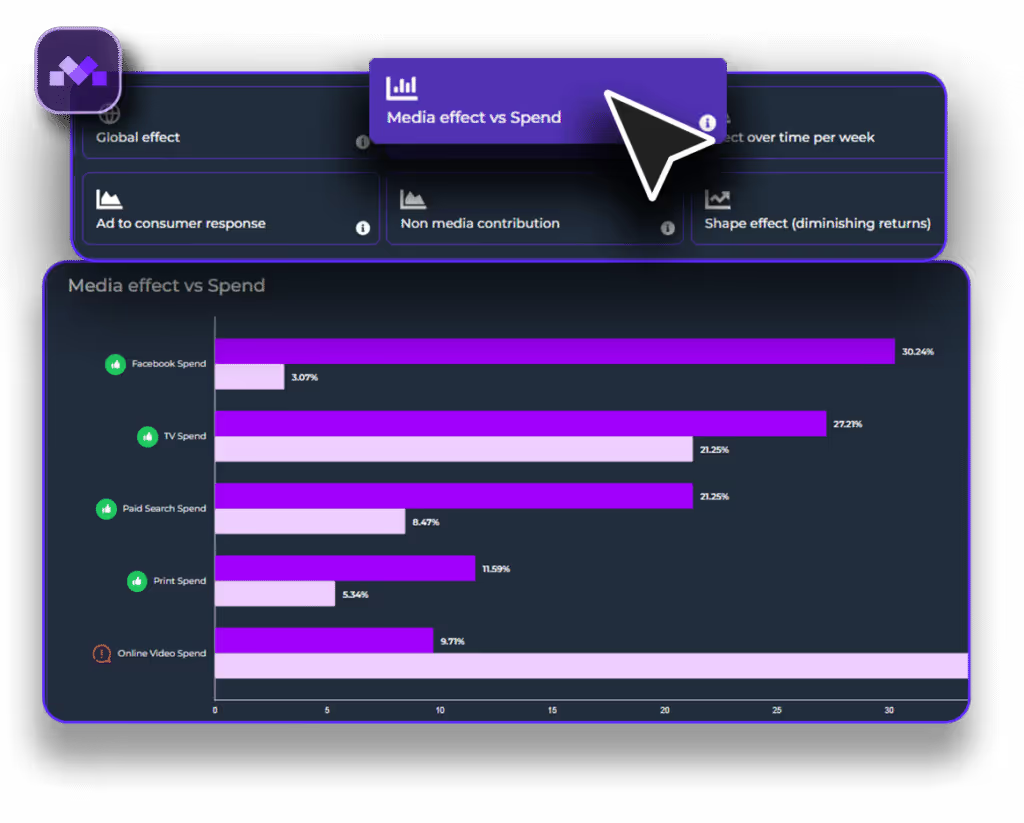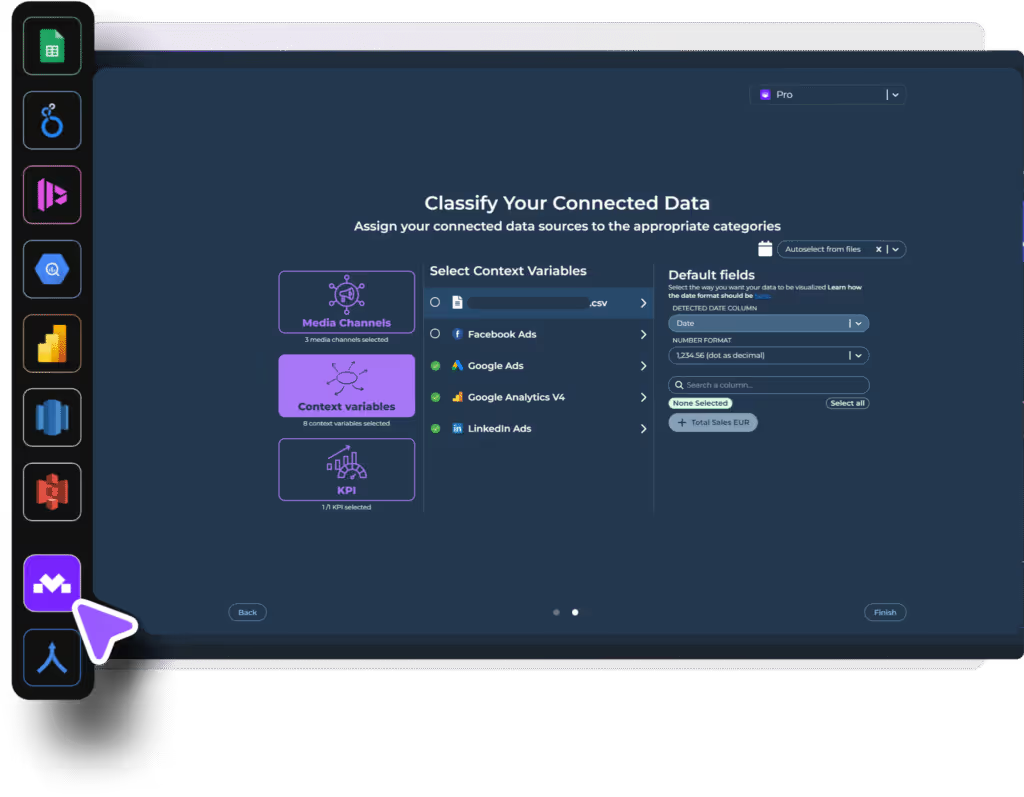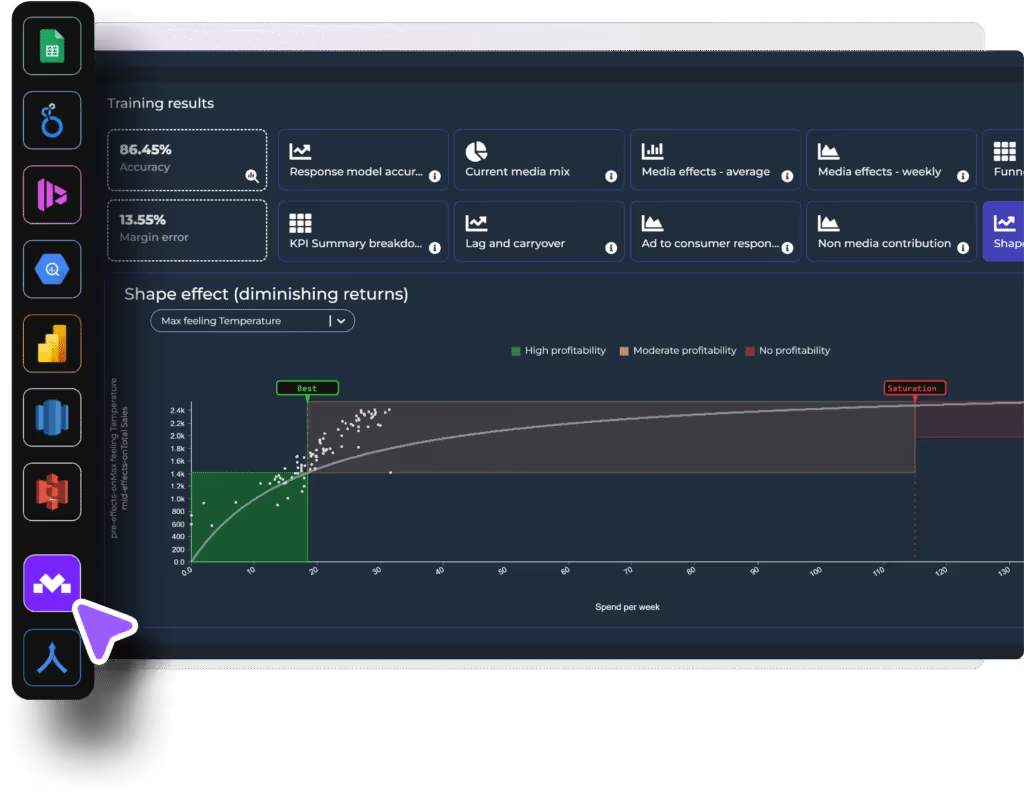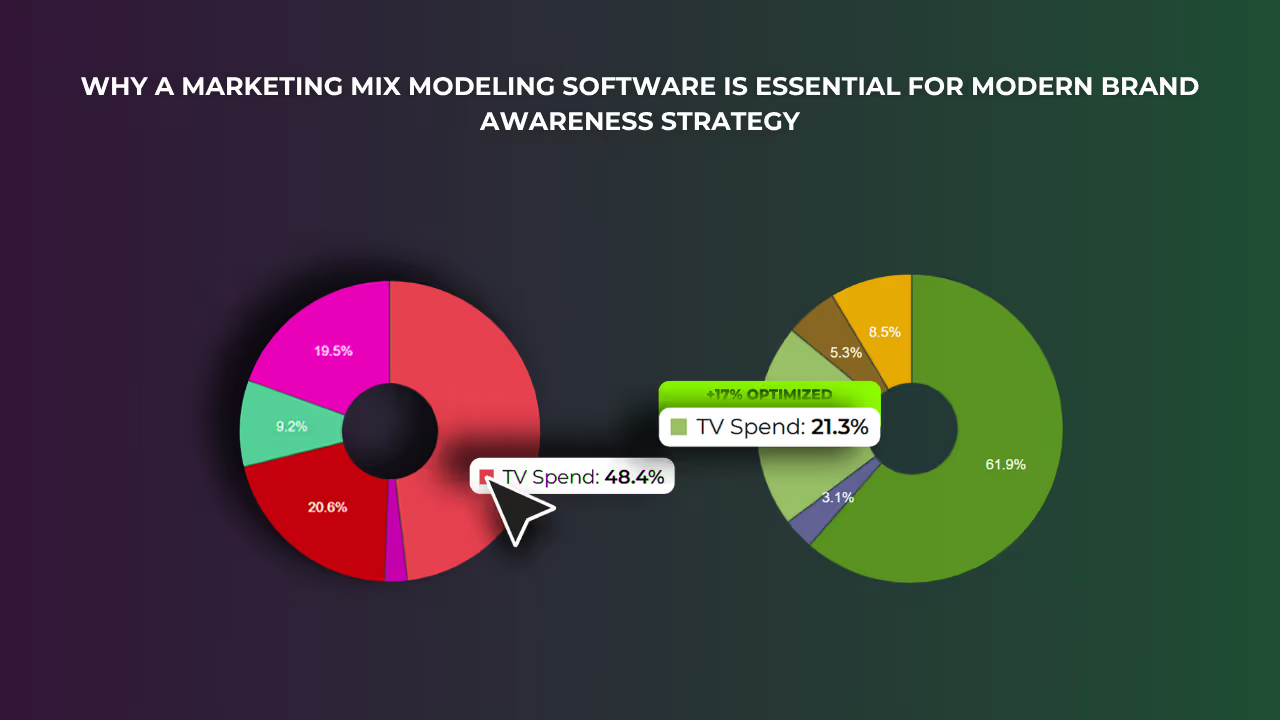Entre unos presupuestos ajustados, unos hábitos de consumo cambiantes y una lista cada vez mayor de canales que gestionar, los profesionales del marketing de hoy tienen más complejidad y responsabilidad que nunca. Demostrar el valor de lo que haces ya no es solo algo que está bien tener, sino que es la base. Ahí es exactamente donde el software de modelado de mezclas de marketing cambia las reglas del juego. Si bien se utiliza con frecuencia para optimizar las métricas de rendimiento, como las ventas o las conversiones, su verdadero poder va más allá. Si te preocupa la salud de tu marca a largo plazo, el reconocimiento de la marca merece un lugar en el centro de tu estrategia de medición.
Esta guía tiene como objetivo ayudarlo a aprovechar al máximo software de modelado de mezclas de marketing, específicamente cuando su objetivo es entender cómo sus inversiones en medios están moldeando la percepción de la marca. Te explicaremos los conceptos básicos en los que se basa el MMM, analizaremos cómo plataformas como Morpheus hacen que el modelado avanzado sea más accesible y destacaremos las técnicas que convierten los datos fragmentados en información útil. Si ya lo estás usando software de modelado de mezclas de marketing o simplemente explorando las posibilidades, obtendrá una hoja de ruta clara para medir y maximizar el impacto de sus esfuerzos de marketing en la creación de marca.
- La importancia estratégica del conocimiento de marca
- El papel del software de modelado de mezclas de marketing en la cuantificación del impacto de la marca
- Un enfoque estructurado para modelar el conocimiento de la marca con el modelado de combinaciones de marketing
- Lo más destacado del estudio de caso: McCann y el crecimiento empresarial
La importancia estratégica del conocimiento de marca
El conocimiento de la marca puede parecer un concepto vago a primera vista, pero desempeña un papel clave a la hora de determinar la forma en que tus esfuerzos de marketing dan sus frutos con el tiempo. No se trata solo de que las personas reconozcan tu logotipo, sino de que formen parte de su proceso de toma de decisiones incluso antes de empezar a comprar. Por eso es importante medir correctamente el conocimiento de la marca y por eso usar las herramientas adecuadas puede marcar una gran diferencia.
Con la ayuda de software de modelado de mezclas de marketing, puedes empezar a ver cómo tus campañas influyen en la notoriedad, no solo en las ventas, y entender qué canales ayudan realmente a las personas a darse cuenta de tu marca y a recordarla. Y eso es importante, porque el conocimiento genera resultados empresariales reales:
- Atrae nuevos clientes al embudo al hacer que tu marca sea más fácil de encontrar y recordar.
- Contribuye al valor de la marca, lo que le ayuda a mantenerse competitivo, cobrar más y lanzar nuevos productos con menos fricciones.
- Hace que su marketing sea más eficiente, ya que las marcas conocidas suelen llegar más lejos con menos gastos.
- Y en mercados abarrotados, te da una ventaja, ya que te asegura que no eres solo otra opción, sino una opción en la que la gente realmente piensa.
Al combinar la estrategia de marca con las ideas que software de modelado de mezclas de marketing puede proporcionar, puede empezar a tratar la conciencia no como algo vago y agradable de tener, sino como una parte mensurable y manejable de su rendimiento de marketing.
El papel del software de modelado de mezclas de marketing en la cuantificación del impacto de la marca
Software de modelado de mezclas de marketing ofrece a los especialistas en marketing una forma de evitar el ruido y comprender realmente cómo sus esfuerzos se relacionan con los resultados. Al analizar los datos históricos, ayuda a analizar el impacto real que cada canal de marketing tiene en un KPI específico, ya sean las ventas, las conversiones o, en este caso, el conocimiento de la marca. Si bien software de modelado de mezclas de marketing se asocia a menudo con las métricas de rendimiento, por lo que su valor para el seguimiento del estado de la marca es igual de importante.
Cuando se trata de medir el conocimiento de la marca, software de modelado de mezclas de marketing ofrece algunas ventajas clave:
- Análisis holístico de canales: En lugar de analizar cada canal de forma aislada, obtienes una imagen completa de cómo funciona todo en conjunto. Esto es importante porque el conocimiento de la marca a menudo proviene del efecto combinado de varios puntos de contacto, no solo de una campaña o plataforma.
- Atribución más precisa: La construcción de marca no sigue una línea recta, y software de modelado de mezclas de marketing está mejor equipado para dar cuenta de ello. Muestra cómo los diferentes puntos de contacto contribuyen a lo largo del tiempo, yendo más allá de la lógica del último clic y reconociendo que la conciencia se adquiere gradualmente.
- Decisiones presupuestarias más inteligentes: Al destacar qué canales ayudan realmente a las personas a darse cuenta y recordar tu marca, el software te brinda una base sólida para reasignar el gasto a donde más importa.
- Perspectivas prospectivas: Una de las características más valiosas de software de modelado de mezclas de marketing es su capacidad para pronosticar. Puedes probar diferentes escenarios y ver cómo las futuras decisiones de marketing podrían afectar a la notoriedad antes de comprometer el presupuesto.

Un enfoque estructurado para modelar el conocimiento de la marca con el modelado de combinaciones de marketing
El uso eficaz del software de modelado de mezclas de marketing para medir el conocimiento de la marca requiere un proceso sistemático. He aquí un desglose detallado:
1. Definir su KPI objetivo
El primer paso para establecer un modelo sólido de marketing mix es elegir el KPI correcto, la métrica que refleja el conocimiento de la marca y se convierte en la base de su análisis. Esto es lo que tienes software de modelado de mezclas de marketing, como Morpheus, intentará explicarlo, por lo que debe responder a los esfuerzos de marketing y ser lo suficientemente estable como para darte señales confiables a lo largo del tiempo.
Desde software de modelado de mezclas de marketing normalmente funciona con datos continuos de series temporales semanales o mensuales, por lo que el KPI elegido debe mostrar un movimiento constante que se alinee con los plazos de la campaña. No todas las métricas de notoriedad se crean de la misma manera, por lo que elegir la correcta depende de la naturaleza de tu marca, de tu mercado y del tipo de datos a los que puedas acceder de forma realista.
Estos son algunos de los KPI más comunes que las marcas utilizan para medir el conocimiento, cada uno con sus ventajas y desventajas:
- Tendencias del volumen de búsquedas (p. ej., Google Trends):
- Descripción: Utiliza los datos de las consultas de búsqueda para medir la frecuencia con la que los usuarios buscan el nombre de tu marca. Esto refleja un interés directo y puede indicar un aumento de la notoriedad.
- Ventajas: Disponible de forma gratuita, proporciona datos semanales y refleja el interés directo de los consumidores.
- Consideraciones: Puede verse afectado por factores externos (por ejemplo, eventos noticiosos), proporciona una medida relativa de conciencia, no una medida absoluta.
- Puntuaciones de recuperación de marcas (de encuestas o paneles):
- Descripción: Mide el porcentaje de personas que pueden recordar espontáneamente tu marca dentro de una categoría de producto o servicio. Esto indica que es lo más importante para ti.
- Ventajas: Mide directamente el conocimiento sin ayuda, un fuerte indicador de la fortaleza de la marca.
- Consideraciones: Las encuestas pueden ser costosas y llevar mucho tiempo, ya que a menudo solo proporcionan datos trimestrales o con menos frecuencia, y pueden estar sujetas a sesgos en las encuestas.
- Impresiones o alcance:
- Descripción: Cuantifica la cantidad de veces que se muestran tus anuncios o la cantidad de personas expuestas a tus mensajes de marketing. Esto refleja la visibilidad.
- Ventajas: Los datos, que están directamente relacionados con el gasto en medios, son fácilmente accesibles desde las plataformas publicitarias, lo que resulta útil para comprender el alcance de las campañas.
- Consideraciones: Sirve como indicador de notoriedad, no garantiza que las personas hayan notado o recordado los anuncios y debe usarse junto con otras métricas.
- Puntuaciones de concientización (de estudios de seguimiento):
- Descripción: Métricas personalizadas de las encuestas de seguimiento de marcas en curso que miden los niveles de notoriedad, a menudo con dimensiones específicas, como la notoriedad asistida y sin ayuda.
- Ventajas: Adaptado a los objetivos específicos de la marca, proporcionando datos muy relevantes.
- Consideraciones: Al igual que el recuerdo de una marca, los estudios de seguimiento pueden ser costosos y llevar mucho tiempo.
2. Preparación de sus datos multimedia
En cualquier modelo de mezcla de marketing, las variables de los medios son las que dan vida a tu actividad de marketing en el análisis. Estas son las palancas que ha utilizado: los presupuestos que ha gastado, las impresiones que ha generado y las campañas que ha lanzado. Para crear un modelo fiable con su software de modelado de mezclas de marketing, necesita datos limpios, completos y bien estructurados que reflejen realmente lo que ocurrió en el mercado.
Estas son algunas cosas clave que debes tener en cuenta a la hora de preparar tus datos multimedia:
- Desglose de canales: Incluye todos los canales de marketing relevantes para obtener una visión holística. Puede agregar o desagregar canales según sus necesidades analíticas y la disponibilidad de datos. Por ejemplo, puede modelar la televisión, YouTube, Display y las redes sociales por separado para comprender sus contribuciones individuales, o combinar todo el gasto digital en una única variable «digital» para realizar un análisis de mayor nivel.
- Consistencia métrica: Utilice unidades consistentes para cada canal para garantizar comparaciones precisas. Las métricas más comunes son:
- Gasto: la cantidad invertida en un canal, que refleja el aporte financiero.
- Impresiones: el número de veces que se ha mostrado un anuncio, lo que indica el alcance.
- GRP: puntos de calificación brutos para la publicidad televisiva, una medida estándar del tamaño de una campaña televisiva.
- Inclusión de medios propios: No pases por alto los canales multimedia propios, ya que también contribuyen al conocimiento de la marca. Incluye canales como boletines informativos por correo electrónico, publicaciones en blogs, redes sociales orgánicas y tráfico de sitios web. Puedes representarlos de la siguiente manera:
- Variables binarias (0 = sin actividad, 1 = actividad) para indicar la presencia o ausencia de una campaña o actividad específica.
- Métricas de volumen (p. ej., número de envíos de correo electrónico, número de publicaciones de blog publicadas, visitas al sitio web) para cuantificar el nivel de actividad.
- Alineación del marco temporal: Asegúrese de que sus datos multimedia se alinean con precisión con el período de tiempo de su KPI de conocimiento de marca para evitar correlaciones engañosas. Por ejemplo, utiliza los datos semanales sobre el gasto en medios con un KPI de notoriedad semanal.
Al configurar tus datos en Morpheus, que proporciona una interfaz fácil de usar para la entrada de datos, puedes incluir el gasto semanal para las campañas de TV, YouTube y Display, las impresiones semanales para las campañas Meta y una variable binaria que indique la presencia o ausencia de un boletín semanal.

3. Incluir variables de control
El conocimiento de la marca está influenciado tanto por los esfuerzos de marketing como por factores externos. Agregar variables de control a su software de modelado de mezclas de marketing mejora la precisión del modelo al tener en cuenta estos factores no relacionados con el marketing, lo que lleva a una comprensión más precisa del verdadero impacto del marketing.
Entre las variables de control más comunes se incluyen:
- Estacionalidad: Captura los patrones recurrentes de conciencia debido a la época del año (por ejemplo, el aumento de la conciencia durante las temporadas de compras navideñas). Puede modelar esto utilizando variables ficticias para meses o semanas, o métodos más sofisticados, como los términos de Fourier.
- Actividad de la competencia: Da cuenta del impacto de las campañas de la competencia en el conocimiento de tu marca. Esto puede incluir la participación de la competencia (SOV), los datos de gastos o las estrategias de precios.
- Lanzamientos de productos: Indica los períodos que rodean el lanzamiento de nuevos productos, que a menudo se correlacionan con un mayor conocimiento debido a los esfuerzos de publicidad y marketing.
- Eventos de relaciones públicas: Incluye importantes eventos de relaciones públicas que pueden influir en la visibilidad de la marca y en la percepción pública.
- Condiciones económicas: En algunos casos, los factores macroeconómicos como la confianza del consumidor o el crecimiento económico pueden ser relevantes, ya que pueden afectar el comportamiento del consumidor y el sentimiento de la marca.
En un software de modelado de combinaciones de marketing como Morpheus, puedes incorporar variables ficticias para cada mes para capturar las tendencias estacionales, datos semanales sobre el SOV de la competencia para tener en cuenta la presión competitiva y variables binarias para las semanas en las que se lanzaron productos para aislar su impacto.
Además de estas entradas manuales, Morpheus incluye conectores para fuentes de datos externas, como las condiciones meteorológicas, los días festivos y los tipos de cambio, factores contextuales que pueden influir en el conocimiento de la marca según el mercado. La estacionalidad también está integrada en la configuración básica de la plataforma, lo que ayuda a simplificar la configuración y reducir el tiempo de preparación. Estas funciones permiten a Morpheus aislar mejor el verdadero efecto del marketing, sin dejarse sesgar por el ruido externo.
4. Transformaciones mediáticas (Adstock y Hill)
La relación entre los esfuerzos de marketing y el conocimiento de la marca no siempre es sencilla. Los resultados no aparecen al instante y el impacto de una campaña puede aumentar o desaparecer con el tiempo. Para explicar esto, software de modelado de mezclas de marketing al igual que Morpheus, aplica funciones de transformación que ayudan a modelar estas dinámicas del mundo real con mayor precisión. En concreto, Morpheus usa Adstock para captar los efectos retardados y decrecientes de la exposición, y la función Hill para reflejar la disminución de la rentabilidad a medida que aumenta el gasto. Estas transformaciones permiten Morfeo ir más allá de las suposiciones básicas y reflejar mejor cómo el marketing realmente influye en la conciencia a lo largo del tiempo.
- Transformación de Adstock: Esto explica el efecto de arrastre de la publicidad. La notoriedad que genera un anuncio en un período determinado no desaparece instantáneamente, sino que disminuye gradualmente con el tiempo. Adstock modela esta decadencia y reconoce que la publicidad del pasado sigue influyendo en la notoriedad actual. Esto es crucial para entender el impacto a largo plazo de las campañas de creación de marca.
- Transformación de la función Hill: Esto aborda la disminución de los retornos. A medida que aumenta el gasto en un canal, el impacto incremental en la notoriedad puede disminuir. La función Hill modela este efecto de saturación y reconoce que hay un punto en el que un gasto adicional produce ganancias cada vez menores.
- Justificación de las transformaciones: La creación de marca es, fundamentalmente, un esfuerzo a largo plazo. Adstock ayuda a modelar cómo se acumula la notoriedad a lo largo del tiempo, lo que refleja la influencia sostenida de las campañas. Las funciones de Hill proporcionan una representación más precisa de cómo cambia la eficiencia del gasto a medida que aumentan los niveles de inversión.

Metodología de Morfeo
A diferencia de los modelos OLS (mínimos cuadrados ordinarios) tradicionales, que proporcionan estimaciones puntuales sin expresar confianza o incertidumbre, Morpheus usa Métodos bayesianos para generar distribuciones de probabilidad completas para cada parámetro. Este enfoque, impulsado por PyMC, permite que el modelo incorpore conocimientos previos, gestione la multicolinealidad de manera más flexible y cuantifique la incertidumbre de una manera que resulta especialmente útil cuando los datos son ruidosos, escasos o desequilibrados, desafíos comunes en el análisis de marketing. El resultado es una comprensión más sólida de la eficacia de los canales, especialmente en entornos complejos en los que los modelos lineales simples son insuficientes.
Para ver más de cerca cómo Morfeo software de modelado de mezclas de marketing funciona en la práctica, incluidas las herramientas para la entrada, el análisis, la optimización y la planificación de datos, que puede explorar su documentación y secciones de interfaz como «Mis datos», «Perspectivas», «Optimización» y «Planificación».
5. Mejores prácticas para medir el conocimiento de la marca
Para garantizar que obtiene la información más precisa y procesable de su software de modelado de mezclas de marketing, tenga en cuenta las siguientes prácticas recomendadas:
- Priorice la calidad de los datos: La precisión y la confiabilidad de las salidas de su modelo dependen directamente de la calidad de los datos de entrada. Céntrese en garantizar la precisión, la integridad y la coherencia de los datos en todas las fuentes.
- Utilice datos granulares siempre que sea posible: Por lo general, se prefieren los datos semanales a los mensuales, ya que capturan las fluctuaciones y tendencias más detalladas, lo que lleva a una comprensión más matizada del impacto del marketing.
- Aborde las anomalías de los datos de forma proactiva: Si tu KPI de notoriedad de marca muestra ruido o contiene valores faltantes, emplea técnicas de suavizado (por ejemplo, promedios móviles) o métodos de interpolación para mitigar estos problemas y mejorar la estabilidad del modelo.
- Tenga en cuenta el impacto retrasado de las campañas: Reconozca y modele los efectos retardados de las campañas de marca en la notoriedad. Asegúrese de que su software de modelado de mezclas de marketing puede incorporar con precisión las transformaciones de los anuncios para representar estos efectos de retraso y proporcionar una atribución del crédito más realista.
- Valide rigurosamente los resultados del modelo: Compare los resultados de su modelo con los eventos del mundo real y las tendencias observadas para evaluar su validez y refinarlo según sea necesario. Esto garantiza que el modelo refleje con precisión la dinámica del mercado.
- Céntrese en la información procesable, no solo en los datos: El objetivo final es obtener información procesable del modelo para informar y mejorar sus estrategias de marketing. Identifique los canales más eficaces, optimice la asignación del presupuesto y prevea el impacto de las campañas futuras.
Cómo elegir el software de modelado de mezclas de marketing adecuado
Una vez que comprenda todo el proceso de modelado, desde la definición de los KPI hasta la aplicación de las transformaciones, queda claro que software de modelado de mezclas de marketing marca una verdadera diferencia. La precisión, la adaptabilidad y la integración con fuentes de datos externas son importantes cuando se mide algo tan matizado como el conocimiento de la marca.
Entre las opciones disponibles, Morfeo, desarrollado por Dataslayer, es un fuerte competidor. Combina una interfaz fácil de usar con funciones avanzadas y conectores integrados para variables como el clima, los días festivos y los tipos de cambio. Estas capacidades pueden ayudar a explicar las influencias externas que los modelos tradicionales podrían pasar por alto.
Al final del día, lo mejor software de modelado de mezclas de marketing es el que se ajusta a sus datos, sus necesidades y su capacidad para actuar en función de los resultados. Morpheus es una plataforma que reúne estos elementos de una manera práctica.
https://youtu.be/FenaE463hCk?feature=shared
Lo más destacado del estudio de caso: McCann y el crecimiento empresarial
Para ilustrar el poder de Morpheus y el modelado de combinaciones de marketing, consideremos el éxito logrado por McCann, una agencia de publicidad global. En un estudio de caso detallado, McCann utilizó Morpheus para optimizar las estrategias de marketing de sus clientes, lo que impulsó un crecimiento empresarial significativo. Al utilizar los datos para comprender el verdadero impacto de los distintos canales de marketing, McCann pudo refinar la asignación del presupuesto, mejorar la eficacia de las campañas y, en última instancia, ofrecer mejores resultados a sus clientes. Este ejemplo demuestra el valor real de software de modelado de mezclas de marketing para hacer que la comercialización sea más responsable y eficaz. Para profundizar en el éxito de McCann y las estrategias específicas empleadas, puede explore el estudio de caso completo aquí.
Al cumplir con estos principios y usar de manera efectiva software de modelado de mezclas de marketing, los profesionales del marketing pueden pasar de confiar en la intuición a tomar decisiones basadas en datos. Esto permite estrategias de creación de marca más eficaces, un mejor ROI de marketing y el cultivo de un crecimiento empresarial sostenible.
¿Tienes curiosidad por poner esto en práctica? Prueba Morpheus y descubra cómo el software de modelado de mezclas de marketing puede ayudarlo a medir y aumentar el conocimiento de la marca con confianza.







